#Baltimore Cruise Port
Text
Discover Parking Options for Baltimore Cruise Port
Setting sail from Baltimore Cruise Port? Trinity Reservations presents hassle-free parking options for Baltimore cruise port. Leave your vehicle with us and embark on your cruise worry-free, knowing your car is in secure hands. Smooth sailing starts with smart parking choices.
1 note
·
View note
Text

live view of me after gilgamesh dropped off my daily morning coffee and went “btw key bridge collapsed” with such casualty and left
#Baltimore#an ENTIRE BRIDGE#you know this morning the healthy harbor initiative people woke up checked the news and just went back to bed. what else can you do#this is honestly one of those in disbelief terrible things that have happened.#not that it helps the families of those on the bridge at the time but thank god it was 1am and not rush hour#but its insane how far reaching the aftershocks of this will play out#7th busiest port in the US and number one in a lot of imports such as cars…#all the cruise ships are stuck in the harbor#traffic for people coming in/out is going to suck now that they can go tunnel only#and transporting certain combustible goods is now going to have to take 1hr+ detour since they cant go in the tunnel#my mother who works for a boating company in Annapolis has boats stuck in the harbor#my fingers are sorta crossed that hopefully we’ll get federal aid for this? idk man 😬
13 notes
·
View notes
Text
Navigating Parking Options for Baltimore Cruise Port Visitors
With its strategic location and rich maritime history, Baltimore has become a favorite launch point for many cruise travelers. However, like many popular ports, finding a convenient and affordable parking spot can be a challenge.
Visit:- https://justpaste.it/8y7vf
0 notes
Text

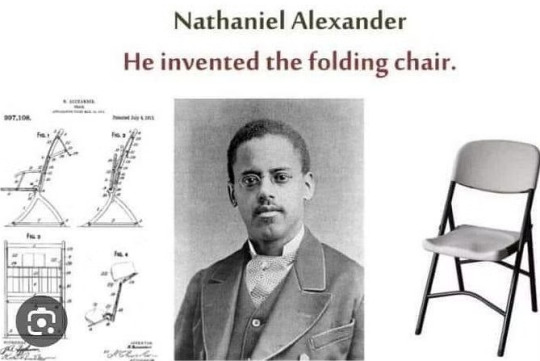
Did Nathaniel Alexander invent the folding chair? Nathaniel Alexander Inventor of a Folding Chair - ThoughtCo
On July 7 1911 an African-American man named Nathaniel Alexander of Lynchburg Virginia patented a folding chair. According to his patent Nathaniel Alexander designed his chair to be used in schools churches and other auditoriums. His design included a book rest that was usable for the person sitting in the seat behind and was ideal for church or choir use.
Fast Facts: Nathaniel Alexander
Known For: African-American patent holder for a folding chair
Born: Unknown
Parents: Unknown
Died: Unknown
Published Works: Patent 997,108, filed March 10, 1911, and granted July 4 the same year
Patent 997108 is the only invention on record for Nathaniel Alexander, but on March 10, 1911, his application was witnessed by two people: James R.L. Diggs and C.A. Lindsay. James R.L. Diggs was a Baptist minister from Baltimore (born in 1865), who was a member of the Niagara Movement, and holder of an MA from Bucknell University and a PhD in Sociology from Illinois Wasleyan in 1906.
in fact, Diggs was the first African-American to hold a Sociology Ph.D. in the United States. The Niagara Movement was a Black civil rights movement led by W.E.B. DuBois and William Monroe Trotter, who assembled in Niagara Falls, Ontario (American hotels barred Blacks), to discuss Jim Crow laws following the Reconstruction.
Folding chairs allow the space to be used for other purposes when there is not a class or church service.







LET THE GOOD TIMES ROLL



OUR ANCESTORS ARE SAYING " NOW THAT IS A NEW MEANING TO THE SAYING HAVE A SEAT, WE SHOULD HAVE THOUGHT OF THAT"
LITTLE DID NATHANIEL ALEXANDER REALIZE IN 1911 HIS INVENTION WOULD BE USE AS A WEAPON OF MASS DESTRUCTION THAT WOULD MAKE THE ANCESTORS PROUD.

HOW IRONIC IS THIS
" ANCESTRAL BEAT DOWN" TOOK PLACE AT THE MONTGOMERY DOCKS IN ALABAMA - THE RIVERBOAT IS CALL THE HARRIOTT AND THE DOCK WAS A SLAVE TRADING PORT.
The Harriott was a slave ship back in the 1700s. From 1798 to 1805, it carried thousands of slaves to Barbados and then back to Liverpool. However, it was owned by Barton & Co and also cruised between Liverpool and Africa. It now serves as a relaxing cruise and is one of Montgomery's tourist attractions.
SO ALL THE ANCESTOR ARE STANDING SMILING PROUD


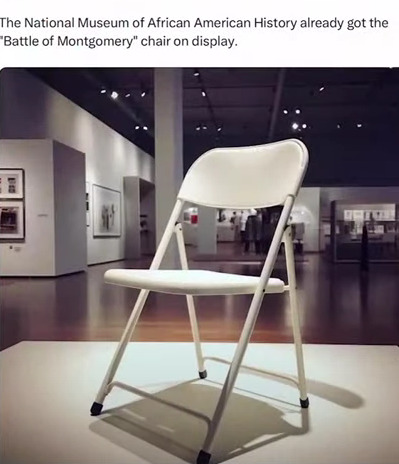

AT BLACK PARAPHERNALIA BLOG WE DO NOT BELIEVE IN ANY FORM OF VIOLENCE OR PERPETUATE THE BEHAVIOR OF WHAT WAS NOTED.
WE HAVE ENDURED AND SUFFERED FOR CENTURIES OF THE WS AND THEM ENTITLE MANNERISM, AGGRESSIONS, BEHAVIORS AND VIOLENT RACISM.
THIS IS A NEW ERA IN THIS 21TH CENTURY WE SAY NO MORE - WE ARE SICK AND TIRED, ENOUGH IS ENOUGH AND WILL NOT TOLERATED ANY SUCH BEHAVIORS, NOT TODAY SATAN.
MOREOVER, IT IS OUR BELIEF THAT WE SHOULD AND MUST DEFEND AND PROTECT ONESELF...... LIKE IN THE WORDS OF OUR ANCESTOR MALCOLM X *BP*
BY ANY MEANS NECESSARY
youtube
youtube

ALL VIDEOS ARE UNDER THE FAIR USE ACT AS LISTED ABOVE
BLACK PARAPHERNALIA DISCLAIMER - PLEASE READ
#black paraphernalia#this is america#THIS IS A SMALL TOWN#FOLDING CHAIR#nathaniel alexander#MAKING THE ANCESTORS PROUD#by any means necessary
20 notes
·
View notes
Text
Smooth sailing: Save time and money with fall cruises from Baltimore
Carnival Pride
For DMV travelers yearning for adventure this fall, the nearby port of Baltimore offers the perfect and convenient departure point. Setting sail from Baltimore means you don’t have to spend money on airfare or deal with potential flight delays. Plus, there are two cruise lines to choose from, Royal Caribbean and Carnival, with itineraries that can take you to the warm waters of…
0 notes
Text
Travel in Style: Mercedes Sprinter Rental in Baltimore, MD.

When it comes to traveling in luxury and comfort, renting a Mercedes Sprinter in Baltimore, MD, offers an unmatched experience. Whether you need transportation for corporate events, family vacations, weddings, or private tours, these high-end vehicles provide the perfect blend of elegance and convenience. In this article, we explore the benefits of renting a Mercedes Sprinter, what you can expect from these rentals, and why Baltimore is an ideal location for your luxury travel needs.
Why Choose a Mercedes Sprinter?
Mercedes Sprinters are renowned for their superior quality, combining luxury, comfort, and functionality. Here are some key benefits of opting for a mercedes sprinter rental Baltimore, MD:
Spacious and Luxurious Interiors: Mercedes Sprinters offer spacious interiors that can comfortably accommodate groups ranging from 8 to 15 passengers. The plush leather seating, ample legroom, and high ceilings ensure a comfortable ride for everyone.
Advanced Amenities: Expect top-of-the-line amenities, including climate control, Wi-Fi, flat-screen TVs, premium sound systems, and multiple USB ports. These features make the journey enjoyable and convenient, whether for work or leisure.
Safety Features: Mercedes Sprinters come equipped with advanced safety features such as lane-keeping assist, blind-spot monitoring, adaptive cruise control, and multiple airbags. These ensure a safe and secure travel experience.
Versatility: These vans are incredibly versatile, making them suitable for various occasions. Whether you need a corporate shuttle, a wedding transport, or a vehicle for a family trip, a Mercedes Sprinter is a perfect choice.
Ideal Uses for Mercedes Sprinter Rentals
A Mercedes Sprinter rental is perfect for a variety of occasions, providing luxury and convenience for every type of travel. Here are some common uses:
Corporate Travel: Impress clients and colleagues with a Mercedes Sprinter. These vans are perfect for transporting executives, hosting meetings on the go, or shuttling teams to conferences and events.
Family Vacations: Make your family trip memorable with a Mercedes Sprinter rental. The spacious and comfortable interiors, along with entertainment options, ensure a pleasant journey for everyone.
Weddings: Add a touch of elegance to your wedding day with a Mercedes Sprinter. Transport the bridal party and guests in style, ensuring everyone arrives at the venue comfortably and on time.
Private Tours: Explore Baltimore and its surroundings with a private tour in a Mercedes Sprinter. Customize your itinerary and travel at your own pace, enjoying the city's rich history and scenic beauty.
Special Events: Whether it's a concert, a sporting event, or a night out, a Mercedes Sprinter provides a stylish and practical transportation solution. Enjoy the convenience of door-to-door service without the hassle of parking.
Why Rent a Mercedes Sprinter in Baltimore, MD?
Baltimore, MD, offers the perfect backdrop for luxury travel with a Mercedes Sprinter. Here’s why:
Convenient Location: Baltimore is strategically located with easy access to major highways and airports, making it a central hub for both local and regional travel.
Rich History and Culture: Known for its historical landmarks, vibrant Inner Harbor, and diverse cultural scene, Baltimore offers plenty to explore. A Mercedes Sprinter allows you to experience the city in comfort and style.
Scenic Routes: The scenic routes around Baltimore, including the Chesapeake Bay and various historical trails, are perfect for leisurely drives. A Mercedes Sprinter ensures you enjoy these views in luxury.
Choosing the Right Rental Service
Selecting the right mercedes sprinter rental Baltimore, MD service is crucial for a seamless and enjoyable experience. Consider the following factors:
Fleet Quality: Ensure the rental company offers a modern and well-maintained fleet of Mercedes Sprinters. Newer models will typically feature the latest amenities and better reliability.
Reputation: Look for rental companies with strong reviews and positive customer feedback. A reputable company will have a proven track record of excellent service.
Customization Options: Some rental services offer customizable packages. Whether you need specific amenities, special seating arrangements, or a tailored itinerary, flexibility is key.
Pricing: While renting a Mercedes Sprinter is a premium experience, it's important to ensure value for money. Compare rates and included features to find the best deal that meets your needs.
Customer Service: Excellent customer service can make a significant difference in your rental experience. Choose a company known for its responsive and professional service, from booking to drop-off.
Conclusion
Renting a Mercedes Sprinter in Baltimore, MD, offers a luxurious and comfortable travel experience for any occasion. Whether for corporate travel, family vacations, weddings, or private tours, these high-end vans ensure you travel in style. By choosing a reputable rental service with a high-quality fleet and excellent customer service, you can enjoy a seamless and memorable journey. Experience the best in luxury travel with a Mercedes Sprinter rental and discover why it is the preferred choice for discerning travelers.
0 notes
Text





🚢CARNIVAL CRUISE🚢
🚢Ship Legend🚢
December 31st, 2023-January 7th, 2024
From Baltimore, Md to Bahamas
2 Guests starting at $1054 PP 💵
Cruise includes: 🐳
Balcony Cabin
Travel Protection
Gratuities 💵
Taxes, fees, and port expenses.
*Prices subject to change with availability*
Licensed, bonded, and insured Travel Agent
Email me @ [email protected]
Call or text (276) 759-3911
#cruise #carnival #fun#adventure #wonderfultravelswithsharon
0 notes
Text
The Port of Funchal today receives three ships, 'Ventura' and 'Azura', two ships on the CAI route, Cruises in the Atlantic Islands, and the 'Artania' which is almost finishing a transatlantic journey.
The three ships are handling a total of 9,698 people, 6,926 of which are passengers.
‘Artania’ was the first to arrive. This 50-night trip began on October 14, in Bremerhaven, with stops in Falmouth, Cork, Azores, New York, Newport, Baltimore, Norfolk, Virginia, Charleston, Florida, Dominican Republic, Puerto Rico, British Virgin Islands, St. Barthelemy, Antigua, Martinique, Barbados, now, Funchal, Porto, A Coruña and returns to the departure port, Bremerhaven, on December 3rd.
The ship departs at 10pm, with 965 passengers and 512 crew, heading to Leixões, after a 17-hour stopover in Madeira.
The ‘Azura’ arrived from Tenerife, with 2,930 passengers and 1,117 crew, for a 16-hour layover.
At 9:30 pm, she sails to Gran Canaria, one of the islands in the Canary archipelago that is part of the itinerary. The trip ends on December 1st, in Tenerife.
The 'Ventura' began this 12-night cruise, in Southampton, on November 23rd, with Funchal being the second stop on this trip, which has planned visits to the islands of La Palma, Gran Canaria, Lanzarote, then Lisbon and Southampton, where the trip ends on December 5th.
The ship departs at 5pm, after an 11-hour stopover in Madeira, taking 3,031 passengers and 1,143 crew on board.
0 notes
Video
youtube
Cruise News - Port Canaveral and Baltimore Seduce new Brands. La Lido Loca
Can we have more Cruise brands sail out of Auckland, please n' thank you? Because both of these were on the wrong side of the US (for me).
Can I get some more pseudo-ferry action (by that, I mean they go one way, then turn back and go the other way, rinse and repeat; Aussie ports to Auckland and Cali to Florida via Panama both sometimes do them). I really want more options Leaving the West Coast of North America for an Alaskan cruise and finishing in Tokyo, Japan, and ideally doing the same in reverse.
1 note
·
View note
Text
Cruise News *BOARDING DAY MISTAKE* Major Cruise Line Updates & More
Cruise news headlines from across the cruise industry.
Carnival Cruise Line has facial recognition technology at these U.S. homeports:
Baltimore
Galveston
Jacksonville
Long Beach
Miami
Mobile
New York
Port Canaveral
Tampa
Let us HELP YOU BOOK YOUR NEXT CRUISE! Email us at [email protected]
Our FREE CRUISE PLANNING GUIDE: https://thetravelscouts.ck.page/b88b9e9648
Our FREE MARDI GRAS CABIN…

View On WordPress
0 notes
Text


9 Days in Canada
14th September, 2023 - 23rd September, 2023
Aboard Vision Of The Seas
Leaving from Baltimore, Maryland
Oceanview Suite
Deposit starting at $359.50 per person
Includes all taxes, fees, Travel Protection, and gratuities
Port of Call:
Boston, Massachusetts
Portland, Maine
Saint John, New Brunswick (Bay of Fundy) for 2 days
Halifax, Nova Scotia
Prices subject to availability, Prices not guaranteed until booked.
Licensed and Bonded Travel Agent.
Contact Athena's Go Travel @678-558-8720 to book this cruise.
Uplift financing available for trip. Certified Uplift Agent.
0 notes
Text

Sixty years ago, N.S. Savannah would have sailed beneath the Francis Scott Key Bridge, entrance to Baltimore Harbor, to ports around the globe. Now the world's first nuclear-powered merchant ship floats alongside Pier 13 of the city's Canton Marine Terminal. Photograph By Bill Newcott
This Ship Was Supposed to Usher in an Age of Nuclear-powered Travel
The N.S. Savannah was built to introduce an atomic age of super-clean, hyper-efficient sailing vessels, but ended up a relic in Baltimore Harbor. Why?
— Story and Photographs By Bill Newcott | April 5, 2023
The world had been living under the threat of nuclear war for the better part of a decade when President Dwight D. Eisenhower had an idea: Let’s give atomic power a makeover. Ike came up with Atoms for Peace, a three-pronged effort to rehabilitate our friend the atom as a harmless harbinger of unlimited possibility. Prong one: domestic nuclear energy. Prong two: nuclear medicine. Prong three: nuclear-powered transportation.
Well, two out of three ain’t bad.
One recent morning I was welcomed aboard the only surviving relic of Ike’s third prong: the N.S. Savannah (“N.S.” stands for nuclear ship), the world’s first nuke-powered merchant vessel. Put into service in August 1962, the hybrid freighter/cruise ship plied the world’s oceans for eight years, carrying trend-setting passengers and cargoes ranging from tobacco to cars, proclaiming to the world the dawning age of super-clean, hyper-efficient, nuclear-powered vessels.
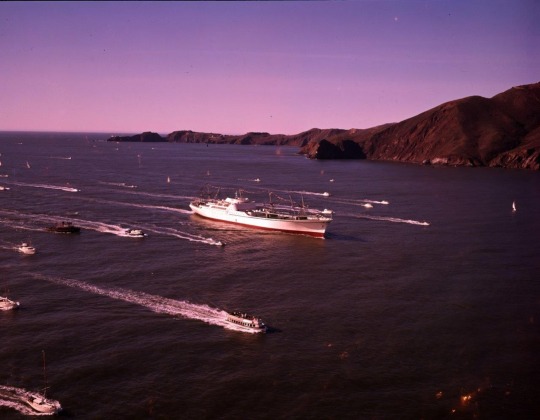
Visiting the U.S. West Coast on her maiden voyage—following a transit of the Panama Canal—N.S. Savannah approaches San Francisco's Golden Gate Bridge November 18, 1962. Photograph Courtesy Maritime Administration, NARA
In those heady days, some 1.5 million people at ports of call around the planet toured Savannah, pushing up the gangway of the sleek white wonder, visiting its space-age control room, and marveling at its iconic logo: two electrons encircling a porthole standing in for the nucleus of an atom.
Too soon, however, the economics of operating a nuclear-powered commercial ship in an age of cheap fossil fuels caught up with Savannah—as did her relatively small size compared to the new container ships. Now, she floats at Pier 13 of the Canton Marine Terminal in a remote corner of Baltimore Harbor, ironically rendered obsolete by her advanced technology.
Still, a defiant Savannah gleams gloriously white against the blue sky and dark water, her stylized electrons still whirling merrily around their portholes. Over the past few years, cars jammed the dock as more than 80 workers dismantled what was left of the ship’s nuclear power plant. The pieces were wrapped up and transported by train to a deep grave somewhere in Utah, completing the job 52 years after the reactor’s shut-down in 1971 and years ahead of the mandatory 2031 deadline.
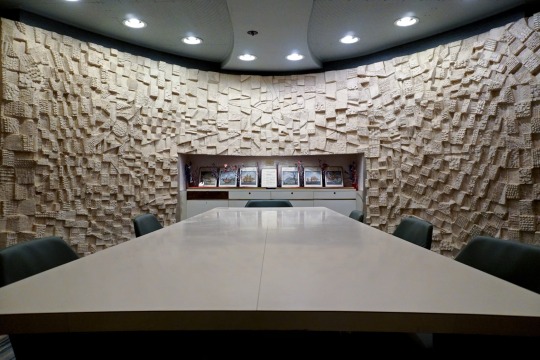
Preferred guests would have been invited to the Captain’s Table—flanked by “Fission,” an expansive wall sculpture by French-born sculptor Pierre Bourdelle. Photograph By Bill Newcott
Nicer Than It Had To Be
“Very ‘Jetsons,’ isn’t it?” observed Erhard Koehler, Savannah’s senior technical advisor and the U.S. Maritime Administration official in charge of the ship. We were standing in Savannah’s lobby, virtually unchanged since launch—a low-ceilinged rectangle bisected by a long, burnt-orange Naugahyde couch. In gold print on the Linoleum reception desk were the words: “The Savannah is a Joint Project of the Maritime Administration and the Atomic Energy Commission.”
Some parts of the ship, like this lobby, appear to have arrived in the 21st century via a time vortex. The plush passenger dining room—with its miraculously intact original carpeting, atom-themed light fixtures, and a captain’s table framed by a vast, curved wall sculpture called “Fission”—seems ready to welcome spiffed-up passengers any second.

Original place settings, emblazoned with the ship’s atom-inspired logo, are preserved in a dining room display case.
On the upper deck, in the broad-windowed, brightly polished Veranda cocktail lounge, the bar is still dominated by its original, striking metallic blue, red, and yellow wine rack. Dramatically backlit, the rack was designed as an inside joke for nuclear science buffs who would have recognized it as representing the Trilinear Chart of Nuclides. Koehler and company have even found an original drink menu (“Atomic Cocktail: $1”).
“We’ve tried to preserve as much of the original look as possible in the public areas,” said Koehler. Considering the wild abandon with which substances like asbestos and PCBs were used in those days, he adds, “It’s not always easy.”
Other sections, like the former passenger cabins, are in decidedly rougher shape, victims of water leaks and rot. Still, it’s clear that Savannah was built nicer than it had to be, with touches one would never have found on a mid-century freighter. That’s because, from its inception, Savannah was meant to be much more than a nuclear-powered workhorse.
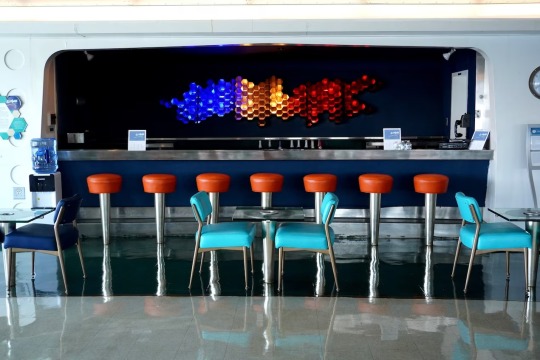
Floating behind the ship's cocktail bar, a multicolored wine bottle rack cleverly mimics the trilinear table of the nuclides, depicting isotopes of the elements.
“The passenger cabins were placed right next to the reactor,” said Koehler as we headed down a stairway to the ship’s holds. Savannah could take 60 passengers—and some of them, I was surprised to learn, slept within 50 feet of a sustained nuclear reaction.
“It was all on purpose,” Koehler said. “Eisenhower wanted everyone to see how safe nuclear power could be.”
Throughout its near-decade as a working merchant ship—then during decades of mothballing, interrupted by a stint as a floating museum near Charleston, South Carolina—Savannah has remained under the ownership of the Maritime Administration. The agency oversaw maintenance of the ship while the Nuclear Regulatory Commission dismantled and disposed of Savannah’s nuclear power plant.
During the final days of the disassembly, Koehler offered to let me see how it was going. We climbed a series of stairways to a chamber at the top of the ship's nuclear reactor. A small window had been cut into plastic sheeting draped atop the wide steel silo that contained the reactor’s innards, some 30 feet below.
Peering through, I looked directly down into the core, where 32 pillars of uranium once generated enough radioactive heat to bring circulating water to about 570 degrees Fahrenheit, creating steam to power the ship’s engine. Instinctively, I glanced at the two radiation gauges clipped to my shirt. Of course, there was nothing to worry about. Still, even with the ship’s nuclear fuel long gone, the team took the hazards of radiation seriously: That morning I had to sit through a 30-minute safety training session just to be permitted this far.
I recalled what Koehler had told me as we walked past an ancient Radar Range microwave oven in Savannah’s kitchen—a model that was so cavalier about the effects of microwaves that it could cook a hamburger with the door open.
“You’d get more radiation in the kitchen than you would standing near the reactor,” he chuckled.
Because of the flurry of workers below, I couldn’t visit the nuclear control room where three engineers monitored Savannah’s nuclear power plant 24/7. A large photo of the control panel sprawled along a passageway wall, showing a seemingly endless array of analog dials, gauges, and switches. Built just before the dawn of digital miniaturization, the whole thing was run with an army of vacuum tubes hidden behind those panels.
That thought delights Bob Adams, president of the N.S. Savannah Association, a nonprofit group of ship enthusiasts whose mission it is to tell the story of Savannah and assist in its preservation.
Adams, a self-described “tube head,” showed me around Savannah’s radio room. On one array, positioned above a seven-inch TV monitor, some 40 tubes bristled at attention.
“The tubes aren’t hard to get,” said Adams, fiddling with the ship’s vintage audio entertainment system. He was playing a CD of steel band music over the speakers, but his ultimate goal was to fire up Savannah’s old reel-to-reel tape player.
“That cabinet over there’s got the ship’s original reels of tape in it,” he said, like a kid anticipating Christmas.
On one wall of the cramped room, taped into place by some long-forgotten radioman, were yellowed sheets bearing broadcast frequencies for ports of call around the world: Portugal, Hong Kong, Okinawa. One of the complications faced by Savannah during her sailing years was the need for special clearances at each destination.
“Whatever the U.S. domestic regulations were for a nuclear power plant, you had to have reciprocity wherever you went around the world,” said Koehler. “A whole administrative structure had to be developed.”
In all, Savannah visited 45 foreign and 32 domestic ports. Only Australia, New Zealand, and Japan refused her entry.
A Future That Never Happened
National Geographic magazine ran a lengthy article about Savannah’s launch in August 1962. “If Savannah works,” writer Alan Viliers noted, “merchant shipping can be revolutionized.”
Savannah operated nearly flawlessly; it was the economics that didn’t work. By 1971, Savannah’s operating costs were outpacing income by $2 million a year. With just a handful of nuclear-powered merchant ships on the high seas, it was becoming clear the world’s shipping companies would prefer pouring tons of oil into their vessels to managing floating nuclear plants—even if those plants could propel their ships 300,000 miles on one load of nuclear fuel.
If the operators had held out for just two more years—when the price of fuel oil went from $20 a ton to $80—the story of nuclear-powered merchant ships might have been very different.
Savannah was listed on the National Register of Historic Places in 1982, but that by no means ensures her future. With the removal of her nuclear apparatus, by law the Marine Administration has three options: find someone willing to take Savannah, sell her for scrap, or scuttle her as an artificial reef.
Environmental concerns almost certainly rule out the last option, but Koehler hopes the ship will survive as a museum for generations to come.
“I think we’ll find somebody,” he said. “We’ve taken good care of her; it’s pretty much plug-and-play for anyone who wants to operate her as a museum.”
We took one last pass through the Veranda lounge. Outside the curving front windows, Savannah’s bell hung above the boarded-over swimming pool. In a display case donated by the Smithsonian Institution, relics of Savannah’s passenger-hauling heyday are on display, including a Bingo ball cage and a pair of wooden horses from an old Steeplechase deck game.
But my attention was drawn back to that magnificent metallic wine rack behind the bar. Koehler had turned on its lights, and it shone with an almost iridescent splendor, radiating optimism for a future that never happened.
It was sad—and at the same time subversively triumphant. I was reminded of the first steam-powered ship to sail across the Atlantic. In 1819 that commercial venture failed, and steam power seemed like a folly.
— The Ship’s Name: Savannah.
0 notes
Text


Baltimore cruise port, a great port to cruise from. Use the local taxi service, it’s about half or less than the cost of an Uber.
0 notes
Photo

15NTS BALTIMORE & CARIBBEAN CLASSICS Was £1849pp NOW fr just £1379pp! Departs 8th Feb 2023 12nts Full Board cruise aboard Enchantment of the Seas Add Premium Drinks from £43pp per day Includes flights FREE 3nts Baltimore stay worth £300 SAVE up to £940 per couple Upgrade to Balcony fr £269pp Baltimore - St Croix - St Lucia - Barbados - St Kitts & Nevis - St Maarten - Baltimore Enchantment of the Seas is a Royal Caribbean Vision-class cruise ship, which currently cruises in the Bahamas year-round. Home porting in Port Canaveral, Florida, she does two weekly cruises: a four-night cruise to Nassau and Coco Bay, and a three-night weekend cruise to the Bahamas, Coco Bay and Nassau. She had a refurbishment in 2005, which added on a 73-foot midsection and some great new facilities and activities. The ship offers scrumptious dining, fantastic entertainment and exiting activities, all while you explore some of the world's most breath-taking destinations. The new mid-section offers a bigger pool deck, new suspension bridges, a Ben and Jerry's ice scream stand as well as a Boleros Latin Lounge and ritzy Champagne bar. (at Birmingham, United Kingdom) https://www.instagram.com/p/CkHRZXzKihX/?igshid=NGJjMDIxMWI=
0 notes
Text
Port of Baltimore has closed 😬
#travel#trip#adventure#honeycruise#honeymoon#baltimore#cruise#port of baltimore#royal caribbean#no update yet from RC#but we have so much time left#much can change#covid-19#covid19
2 notes
·
View notes
Text

USS Macon (CA-132), a Baltimore-class heavy cruiser of the United States Navy, was laid down on 14 June 1943 by the New York Shipbuilding Corp., Camden, New Jersey and commissioned on 26 August 1945. Macon's first fleet assignment was with the 8th Fleet, which she joined soon after her shakedown cruise on 1946. With the outbreak of the Korean War in June 1950, became the flagship of Cruiser Division 6 in the Atlantic. She patrolled in the eastern Mediterranean during the Suez Crisis of 1956. Besides these duties, Macon continued to receive experimental equipment for testing throughout the period. Having also received missile equipment during January–March 1956. On the night of 19–20 January 1959, Macon, steaming from Cartagena to Marseille, diverted from her course and sped to the aid of burning Italian merchant ship Maria Amata. Macon's crew fought the flames, but the ship was soon beyond salvage. Macon then carried the merchantman's crew to Valencia, Spain. Macon was placed out of commission in reserve at Philadelphia on 10 March 1961. Scrapped on 5 July 1973 in Port Newark, New Jersey.
18 notes
·
View notes